Do Boycotts Work? Two Years On, Brand Exits From Russia Are Having an Impact
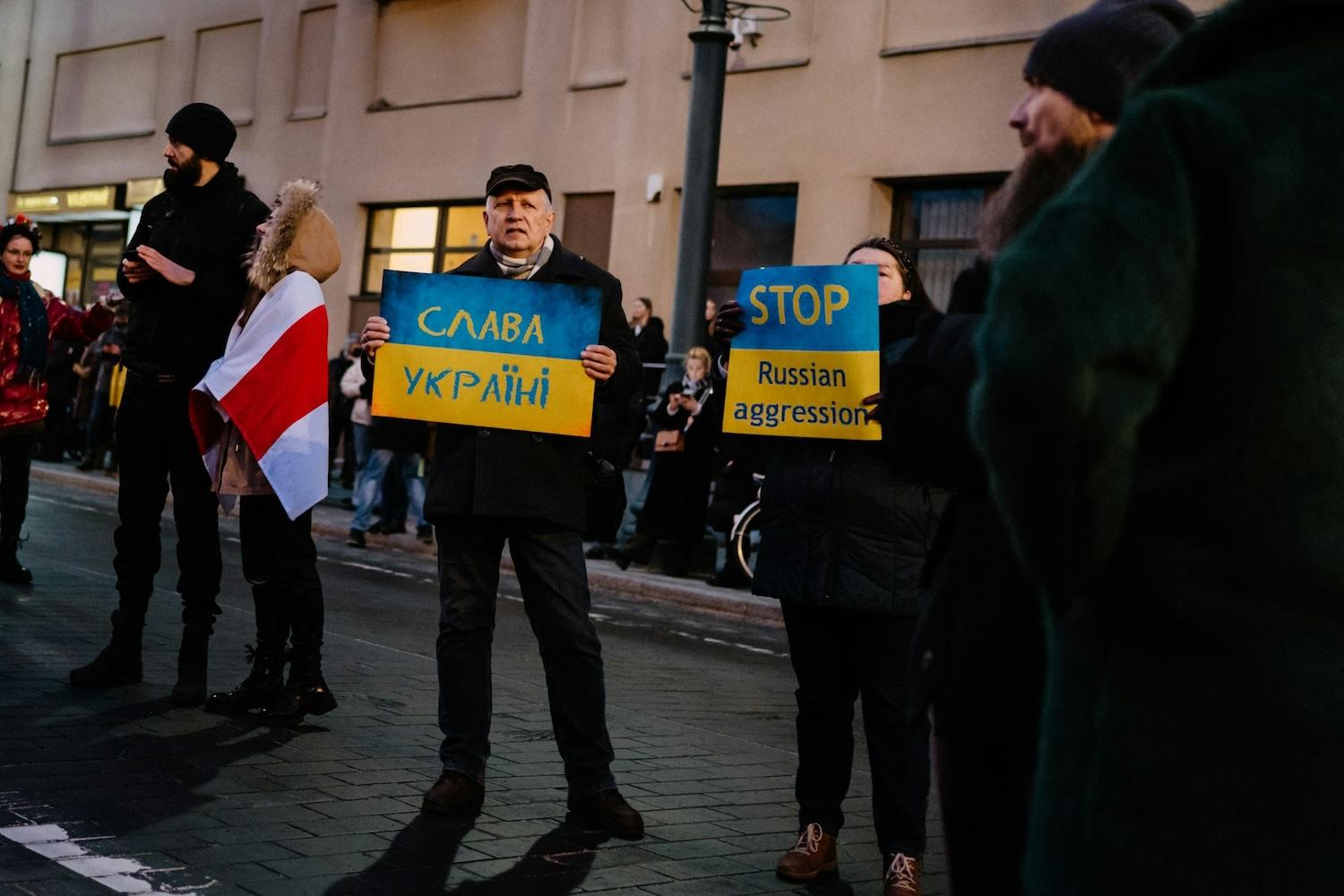

Lithuanian people protesting agains Russian invasion of Ukraine in February 2022. (Image: Dovile Ramoskaite/Unsplash)
Hundreds of leading brands and other companies stopped doing business in Russia after its unprovoked invasion of Ukraine in 2022. Despite the boycott, the war dragged on for more than two years with no end in sight. In that context, it may be fair to ask if the boycott has had an impact. However, the real question is whether businesses have any choice but to act as best they can when confronted by authoritarian power.
Two options: Boycott, or stay and risk a takeover
Last week, Russian President Vladimir Putin summarily seized companies belonging to the agribusiness AgroTerra. The company's assets were placed under the temporary management of the Russian federal property management agency Rosimushchestvo, Bloomberg reported.
AgroTerra operates within Russia, but it is owned by the U.S. investment firm NCH Capital as part of a longstanding interest in Eastern European agriculture. Founded in 2008, AgroTerra operates farms in the fertile Central Black Soil region south of Moscow that provide commodity and specialty crops to food processors.
Arguably, companies that support important food systems have ethical reasons to continue operating, regardless of wartime. An April 9 report by Reuters suggests that AgroTerra falls into that category. As of May 2023, the company was listed among the top 20 agricultural landholders in Russia.
As of this writing, Putin’s new decree has not impacted AgroTerra operationally. The company told Reuters “it was operating as usual" and was primarily focused on sowing seeds for the coming season.
Still, the takeover is the most recent example of the risks that can come with a shift toward authoritarianism.
So, is the brand boycott against Russia working?
The news about AgroTerra and NCH is also important because it provides further evidence that the voluntary boycott has had a significant impact on Russia’s financial ability to wage war.
Days after Russia launched its attack on Ukraine in 2022, the Yale School of Management began keeping a meticulously researched database of non-Russian companies doing business in Russia. So far, almost 1,000 of the 1,500 companies in the Yale database are listed as completely withdrawn. Others have cut back their operations, while some receive an “F” grade for continuing business as usual.
By May 2022, the Yale team gathered enough data to conclude that those withdrawing from Russia realized long-term financial benefits, despite the risk of loss. “We find that equity markets are actually rewarding companies for leaving Russia while punishing those that remain behind,” they summarized on May 31, 2022.
A few months later, the team noted evidence that the voluntary boycott was working in support of international sanctions against Russia. “Far from being ineffective or disappointing, as many have argued, international sanctions and voluntary business retreats have exerted a devastating effect over Russia’s economy,” they reported.
Still, as the war entered its second year, skeptics continued to dispute the effectiveness of the boycott. In December, for example, the New York Times published an article under the headline, “How Putin Turned a Western Boycott Into a Bonanza,” which argued that Russia has profited from the boycott.
The Yale team promptly disputed this account, arguing the article merely amplified propaganda from top Russian officials. “The last word is given to Dmitri Medvedev, the unhinged former Russian president who casually and regularly threatens to use nuclear weapons against Ukraine,” the team wrote in a rebuttal published by Fortune. “No wonder the Russian government is enthusiastically tweeting out the NYT article across official accounts."
In an eerily prescient observation, they also argued that Russia survives “merely by seizing assets" from foreign entities as well as Russian companies and citizens. “The increasingly state-dominated economy is cannibalizing its own companies to maintain Putin’s war machine,” they wrote.
In a more recent sign the Russian government is desperate for cash, in February Putin signed a new law formalizing and extending the confiscation of “money, valuables and other assets” from Russian citizens.
Pressure builds on the U.S. Congress to support Ukraine
The new confiscation law specifically applies to anyone “convicted of spreading ‘deliberately false information’ about the country’s military," the Associated Press reported.
While these factors indicate Russia's war coffers are running low, the conflict is likely to continue until Ukraine receives enough aid to repel the invaders and restore its legitimate boundaries. In the face of that resistance, a voluntary boycott is not enough.
U.S. aid for Ukraine has been held up in Congress for months amidst opposition from Republican representatives. The holdup from GOP lawmakers garnered rebukes from members of their own party. Outside researchers and Congressional colleagues including U.S. Reps. Mike Turner (R-Ohio) and Michael McCaul (R-Texas) say many of the lawmakers opposed to the aid package repeat Russian talking points and disinformation in their arguments against it on the House floor.
In his annual letter to shareholders earlier this month, JPMorgan Chase CEO and Chairman Jamie Dimon is the latest to voice support for an aid package for Ukraine and take aim at the chaotic state of Congress.
"America and the free Western world can no longer maintain a false sense of security based on the illusion that dictatorships and oppressive nations won’t use their economic and military powers to advance their aims — particularly against what they perceive as weak, incompetent and disorganized Western democracies," Dimon wrote. "America’s global leadership role is being challenged outside by other nations and inside by our polarized electorate. We need to find ways to put aside our differences and work in partnership with other Western nations in the name of democracy."
In particular, he singled out Ukraine as "the front line that needs immediate support" and argued "providing that support is the best way to counter autocratic forces."
Dimon’s warning of a “weak, chaotic and disorganized” democratic process rings all the more true this week, as Republican Speaker of the House Mike Johnson attempts to bring a long-delayed Ukraine aid package to the floor for a vote even while facing calls to resign from members of his party. If Republican representatives are having a hard time finding common ground to unite behind their own speaker, perhaps it would help if other business leaders would speak up with the same clarity and force to help them find a way.
Third-Party Verification Labels Can Guide Sustainable Shopping, If Consumers Know About Them


The Marine Stewardship Council's MSC blue label appears on a pack of fish fillets. Seafood products bearing the blue label come from fisheries certified as sustainable by MSC. (Image courtesy of the Marine Stewardship Council)
A growing segment of consumers are looking to purchase more sustainable products, but many aren't sure how to determine which products are sustainable. It's hard to blame them, as the ever-increasing volume of sustainability claims creates confusion and makes it harder to differentiate verifiable product attributes from marketing fluff.
Third-party verification labels can help point consumers in the right direction, but only if people know what these labels mean and why they should look for them on the products they buy. Product certifiers, brands and retailers all have a role to play in building awareness of green labels so they have a greater impact on consumer purchasing.
More consumers want to shop sustainably: Green labels can help
More than half of U.S. consumers say social and environmental considerations have more influence on their purchases today than they did a year ago, TriplePundit found in the $44 Billion Sustainability Opportunity report, published this spring in partnership with our parent company 3BL, the research technology platform Glow and panel partner Cint.
Of the consumers who don't factor in social and environmental considerations significantly when they shop, a quarter said it’s because they “don’t know enough about the sustainability credentials of brands.” Another 18 percent don’t see “any significant difference” in sustainability performance across brands, while around a fifth said they don’t trust brand sustainability claims.
If consumers recognize them and perceive them to be valid, third-party verified green labels can help to address all of these concerns and unlock more consumer spending based on sustainability. Already, sustainability-driven brand switching added up to more than $44 billion across 12 industries in the U.S. alone last year, according to our research.
"People are increasingly conscious of their purchasing habits and want to make sure they are shopping for products that match their values," said Nicole Condon, U.S. director at the Marine Stewardship Council, a nonprofit certifier of sustainable seafood. "We’re seeing that consumers are growing more aware of how their purchasing habits impact the environment, and, when given the information to make a more sustainable choice, they’re doing just that."
Labels, labels everywhere
Take a walk through any store, and you'll find no shortage of sustainability claims on product packaging. Some claim the product is "green" or "eco-friendly," while others tout attributes like "natural," "low-waste" or "low-carbon."
But it's important to distinguish between marketing claims and those that are verifiable and substantiated by third parties. Claims like "green" and "natural" are not regulated by the government in most countries, meaning any brand could slap these labels on any product without consequence. "Consumers are bombarded by product sustainability claims," Condon said. "This makes it increasingly difficult to identify which labels are credible."
Some products bearing these claims may indeed be healthier or come with a lighter impact on people and the environment, but it's impossible for consumers to differentiate a product that's truly more sustainable from another that's sleekly marketed based on these labels alone. While countries including those in the European Union moved to ban claims like these without evidence, those regulations don't come into force until 2026 or later.
In the meantime, third-party verification labels can help point consumers toward products with specific attributes that reduce their impact on people and the planet.
The Marine Stewardship Council, for example, uses a set of standards to verify that wild fisheries do not impact marine ecosystems and that seafood supply chains are free of human rights issues like forced labor. Other third-party verified labels include Fairtrade certification for supply chain worker rights, Energy Star certification for energy efficiency, and Bluesign certification for sustainable clothing and textiles, among many others used around the world.
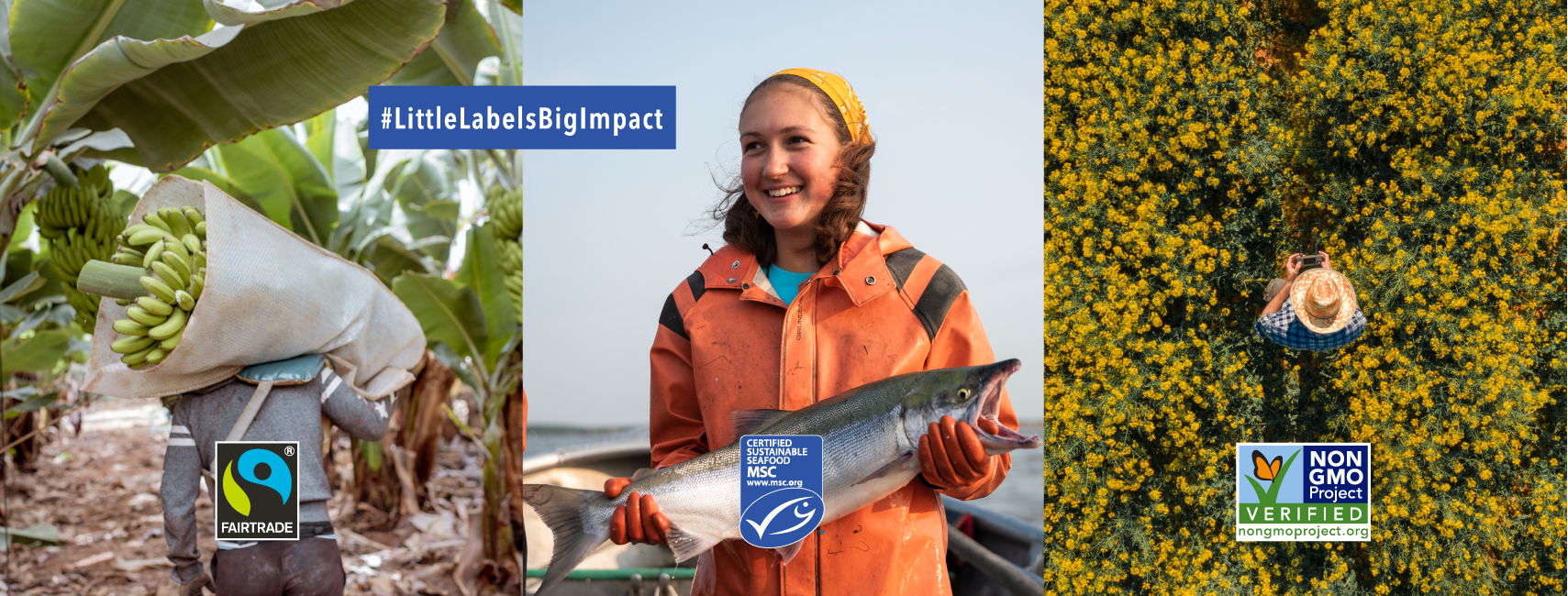
Raising awareness of third-party verification labels
While they aren't regulated either, third-party verification labels indicate a product has met a set of standards for sustainability and social responsibility based on auditing from the certifier.
Sustainability advocates sometimes question whether various third-party certifiers go far enough. But importantly, the standards they use are publicly available, giving consumers information and the power to decide for themselves. Still, that doesn't mean much if consumers don't recognize third-party green labels or know what they mean.
Every year, the Marine Stewardship Council teams up with Fairtrade America and the Non-GMO Project for the Little Labels, Big Impact campaign to raise awareness of third-party verified green labels and why they are important.
"The Little Labels, Big Impact campaign educates shoppers about the rigor behind third-party verification around product claims," Condon said. "These 'little labels' help shoppers avoid greenwashing — also known as deceptive marketing claims that make products seem sustainable — highlighting more sustainable products that support producers and preserve nature’s integrity."
The campaign looks to inform consumers about what brands must do in order to use the MSC blue label for sustainable seafood, the Fairtrade America label for worker compensation and rights, and the Non-GMO Project Butterfly seal for avoidance of genetically modified organisms.
"Transparency lies at the heart of this initiative," Condon said. "Participating organizations uphold transparency by openly sharing their standards, data and financial information on their websites. Furthermore, they actively ask for input from stakeholders to create accountability."
Beyond messaging on social media, the campaign looks to engage retailers and brands to educate their customers about why green labels are important through email and social media marketing, as well as messaging on-pack and in-store. The campaign reached more than 2.6 million people in the U.S. last year, according to the Marine Stewardship Council.
When consumers are aware of green labels, research indicates they're more likely to seek them out while shopping. Nearly 70 percent of U.S. consumers who recognize the Fairtrade label prefer to shop at retailers that carry certified products, according to 2023 polling conducted by GlobeScan on behalf of Fairtrade America. Similar research from GlobeScan and the Marine Stewardship Council indicates that 65 percent of U.S. consumers are looking for third-party verified labels from brands and at retailers.
While the Little Labels, Big Impact campaign offers an example to follow, of course it's just the start when it comes to helping consumers tell fact from fiction while shopping for sustainable products. Retailers like Aldi and Whole Foods Market and brands ranging from outdoor gear label REI to ice cream favorite Ben & Jerry's message regularly about the green labels their products carry and what they mean for consumers, supply chain workers and the environment.
Meanwhile groups like the Marine Stewardship Council look to shake up their messaging throughout the year to reach new audiences with this information. "We’re excited to work with some of our commercial partners on an Earth Month themed campaign in April and use World Ocean Day in June to raise awareness about the important role sustainable fishing plays in a healthy ocean," Condon said as an example. "We’ll continue supporting certified fisheries and work with fisheries interested in getting certified, as well as support our commercial partners along the supply chain."
Meet the Family Farmer Growing Your Avocados

Hass Avocados being harvested in a grove in Michoacán, Mexico.
Avocado trees are native to southern Mexico, where they grew as wild cultivars for thousands of years before the Aztec and Maya people began growing the crop domestically. Today, avocado production is an economic powerhouse for the region.
The avocado industry has enjoyed record-breaking growth in recent years, and per-capita consumption in the U.S. has steadily climbed, as well as avocado imports from Mexico. The dramatic growth in avocado imports has been good for the U.S. economy, according to a report from researchers at Texas A&M University’s Agribusiness Food and Consumer Economics Research Center in partnership with Avocados From Mexico. In fiscal year 2021-2022, U.S. imports of Mexican Hass avocados added $6.1 billion to the U.S. gross domestic product and created 58,299 jobs. On the Mexican side of the border, hundreds of thousands of people earn their living from the prized fruit.
Michoacán, a Mexican state on the western coast, is at the heart of the country's avocado sector and produces 73 percent of all avocados grown in Mexico. It is also where Martin Mendoza calls home and where he has been growing avocados since he was 16 years old. “My mother started our family’s farm in 1980, and my brothers and I started growing avocados then,” he told TriplePundit.
Michoacán: The global center of avocado production
Today, Mendoza and his four brothers manage a 250-acre operation, where they grow 15,000 avocado trees, divided into five orchards. “Our farm is spread out at diverse elevations between 1,400 and 2,700 meters above sea level,” Mendoza explained. “The difference in climates at the various locations allows us to harvest avocados year-round.”
Michoacán is a lush environment, with rainforests, pine forests and deciduous forests spread throughout the state. “From my orchards, you can see the Colima Volcano. In the past few weeks, it has had snow on top of it that we can see from the farm,” Mendoza reflected.
Mendoza typically starts his day on the farm around 7 a.m. When his employees arrive, they go over their plan for the day and address any production problems before any other work begins. While the farm’s full-time work crew consists of 20 employees, during times of heavy harvesting, they also manage outside picking crews.
Approximately 90 percent of avocado imports in the U.S. come from Mexico, and until recently, Michoacán was the only Mexican state to meet the rigorous requirements of the U.S. export program — which includes certifying the fruits are free from pests and plant disease, among other requirements. “We have participated in the export program since its inception, and we export mostly to the U.S.,” Mendoza said of his farm.

Ensuring sustainability and safety
Mendoza has spent decades learning about the needs of avocado trees. For example, avocado trees are highly sensitive to changes in temperature and precipitation. With much of Mexico experiencing drought, farmers are conscious of water use. “Climate change has affected our entire region,” Mendoza said. “However, in Michoacán we are blessed with a lot of rainfall. It rains most months of the year, and the rich, volcanic soil in Michoacán holds moisture and keeps the avocados alive without the use of irrigation.”
In Mendoza’s orchards, 80 percent of his trees rely solely on rainfall and soil moisture, and only 20 percent require additional irrigation. To ensure maximum uptake and avoid runoff, Mendoza utilizes micro-sprinklers and drip irrigation. These microirrigation technologies allow for greater precision by directing water only to the trees that need supplemental irrigation. Additionally, Mendoza harvests rainwater during the months with higher rainfall to use for irrigation during dry seasons.
The farm also invests in food safety and quality, and for Mendoza, that starts with the health of his employees. All employees undergo regular testing to ensure that nobody is sick while handling the avocados, and the Mendozas provide medical services for all employees working in their orchards.
They also monitor their water supply and ensure that any agricultural product that touches the avocados is environmentally-friendly and safe for consumers. “The guidelines for the export program are very strict, and they cover employees, tools, chemicals and more. We have to be impeccable,” Mendoza said.
Mendoza’s farm also carries additional responsible agriculture certifications, including Global GAP, and they employ a monitor who ensures that all outside picking crews and other employees are following responsible farming practices in each of the five orchards.
“We are very careful about the environment,” Mendoza said. "We take care of the land because we depend on it. Responsible farming practices are generally a key characteristic of Michoacán.”
Family farmers in Michoacán drive the avocado sector
The avocado sector in Michoacán provides an economic boost to the entire region through employment opportunities and additional outside investments, but this vibrant local economy would not be possible without the hard work of family farmers.
About 80 percent of avocado growers in Michoacán are smallholders with less than 12 acres, Mendoza said. “The avocado industry benefits thousands of farming families. There are 180,000 hectares in the avocado export program, but they are mostly the small family farms that support this industry.”
Running a larger farm in a sector that provides so many in the community with a livelihood is a lot of responsibility, but Mendoza said he embraces it.
“Avocados are the main economic engine of our state in terms of job creation and the economy,” he said. “My main challenge as a grower is to continue to export and continue to grow so I can generate employment for my community, but I am motivated by the challenge of making a good name for avocados from Michoacán. I am very proud to be Michoacáno.”
This article series is sponsored by the Avocado Institute of Mexico and produced by the TriplePundit editorial team.
Images courtesy of the Avocado Institute of Mexico
The Political Path Forward on Climate Change
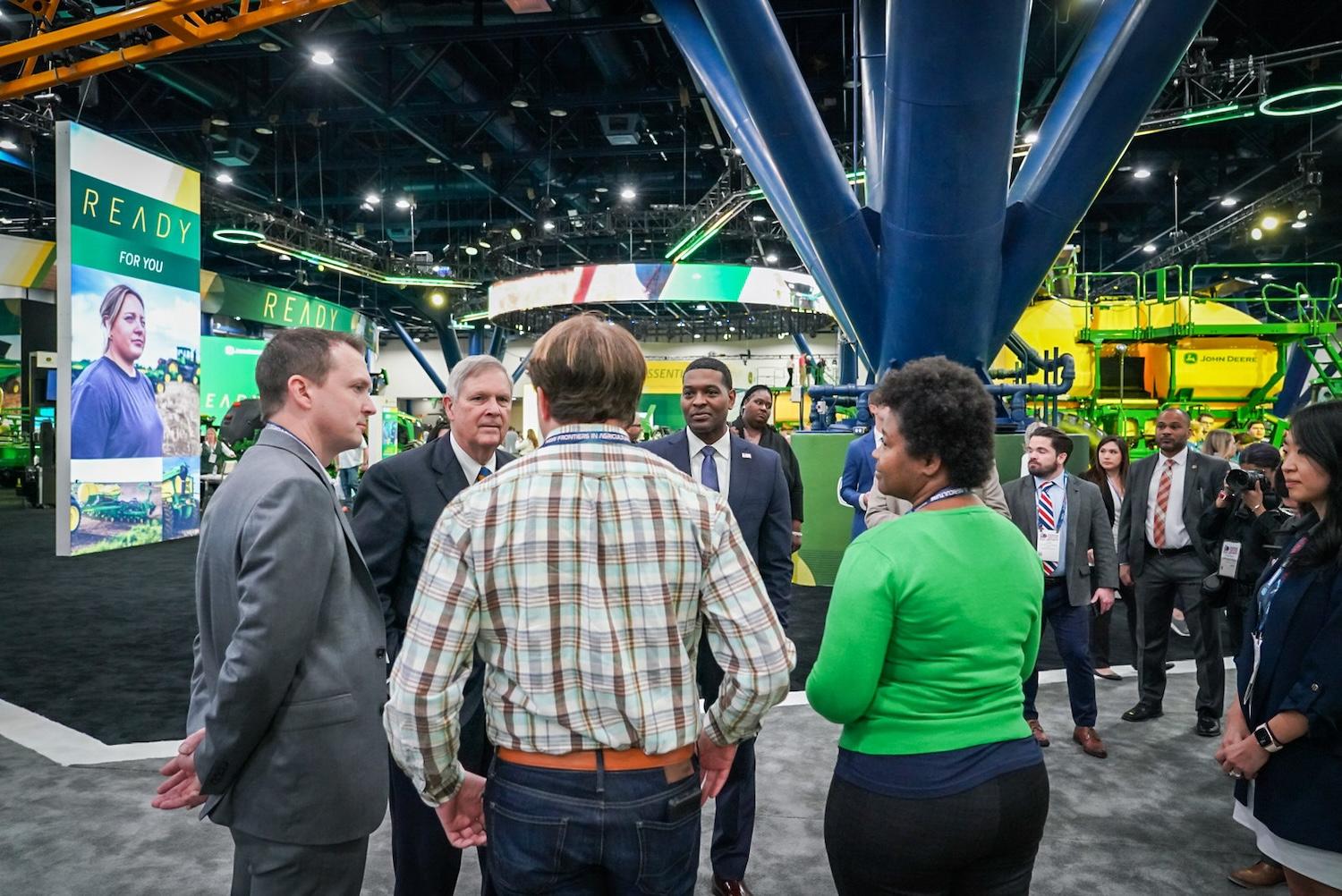
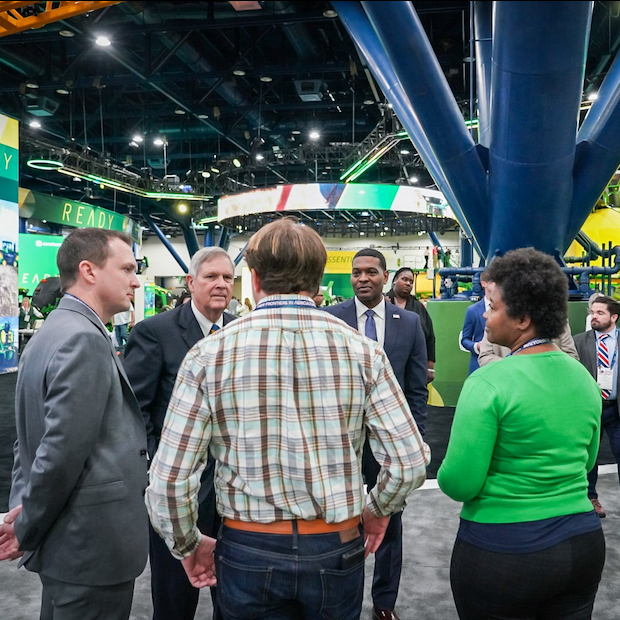
In March, U.S. Secretary of Agriculture Tom Vilsack (back left) and U.S. EPA Administrator Michael Regan (back right) visit the 2024 Commodity Classic in Houston, Texas, the largest farmer-led annual convention in the country, to announce a new EPA office aimed at expanding engagement opportunities with agricultural and rural communities. (Credit: U.S. EPA/Flickr)
This story is part of From the Frontline, a guest-contributed column where we hear directly from climate justice advocates and those who are impacted by climate change. If you're interested in contributing your perspective to this column, please get in touch with us here.
When U.S. President Joe Biden stepped up to deliver what might be his last State of the Union address last month, the growing partisan divide was hard to ignore. The indiscriminate impact of climate crises, as witnessed through record-breaking heatwaves, devastating wildfires and increased domestic climate migration, underscores that climate concerns transcend partisan lines.
Despite the pressing nature of climate change, it often ranks lower on the list of priorities for voters globally, overshadowed by immediate economic concerns. However, here in the United States, a noteworthy shift is emerging within the conservative demographics, particularly among younger Republicans, who increasingly view climate change as a critical issue.
This shift among younger conservatives and the consistent climate concerns from liberal voices presents an opportunity for both the Republican and Democratic parties. By working together across political and socioeconomic lines, we have an incredible chance to tackle the biggest environmental and economic challenges facing our nation.
The green transition isn’t partisan; it’s inevitable. As clean technologies become increasingly affordable and drive down costs, public and private investment in climate solutions will bring unprecedented economic benefits to red, blue and purple states. From creating well-paying green jobs to reducing our reliance on fossil fuels and improving public health, these investments hold promise for creating a more resilient economy while reducing costly carbon emissions.
Climate investments are set to skyrocket even further in 2024 with the rollout of substantial funds from the Inflation Reduction Act, like the $20 billion in climate finance awards the U.S. Environmental Protection Agency announced last week. These awards will increase access to financing for green projects for households and businesses in communities across the country. The initial $20 billion is expected to yield more than $250 billion in combined public and private investment over the next 10 years and create 1 million direct jobs, according to a recent study. This rapid growth will create a green market that lowers energy costs, bolsters economic development, and positions the U.S. as a global economic power.
Despite the historic economic growth that’s on the horizon, the current polarized political landscape makes common ground increasingly difficult to find.
The looming contest for the White House between President Joe Biden and former President Donald Trump underscores this dilemma. While Biden's campaign resonated with young climate voters in 2020, the issue has since receded from the forefront of political discourse in 2024. And that’s not all that surprising. In an early poll of young voters, only 26 percent identified climate change as one of the top three issues on the ballot, while 53 percent were concerned about the cost of living and inflation.
However, it’s important to note that the environment and the economy go hand in hand. For young voters on both sides of the aisle, there is a vital opportunity for Democrats to educate voters about the economic opportunity that an inclusive green economy will provide, especially the imminent expansion of green bank financing. Republicans should also listen carefully to the unique concerns of green conservatives and remain curious and creative in evolving the Republican platform to be inclusive of climate issues.
Businesses, local governments and families nationwide are showing an unprecedented appetite for climate solutions. Green technologies are now more cost-effective than fossil fuels, driving this demand. As the world continues to seek low- or zero-emission technologies, states across the political spectrum are attracting billions in clean energy and electric vehicle manufacturing, resulting in millions of new jobs.
To ensure no one is left behind in the green transition, we need to bridge knowledge gaps, work across divisions and create a shared vision of a more equitable, sustainable future. Some communities have already started that difficult, critical work like Fresno, California.
Thanks to Inflation Reduction Act funding, diverse stakeholders in Fresno are working together to create a climate plan that reduces pollution, expands clean energy, and promotes economic growth. Representatives from both sides of the aisle and across sectors have a seat at the table to build a healthier, more sustainable roadmap for their community. As Republican Mayor of Fresno Jerry Dyer puts it, “During heat waves, Republicans and Democrats both sweat the same.”
This kind of deep, bipartisan collaboration is critical for communities like Fresno that are most impacted by climate change but least likely to be a part of the solutions. While environmental and economic injustice is often prevalent in communities of color, these same patterns of disparity are felt by poor rural communities in red states as well.
Republicans and Democrats alike need to uplift the concerns of their constituents that have been left unheard. They should also meaningfully engage communities to adequately advocate for their unique needs and address knowledge gaps. At all levels of government and across sectors, leaders should turn toward each other through unlikely partnerships and build the inclusive green economy our planet urgently needs and our communities rightly deserve.
The opportunity for transformation doesn’t stop there, and the need for unity extends beyond Capitol Hill and our nation’s borders. In our families and communities, we should seek ways to bridge divides and find common ground on climate. This bipartisan approach to change-making is also needed at a global scale. At the 2023 United Nations Conference of the Parties (COP28), participants from across the globe emphasized the critical role of cross-sector partnerships and collaborative innovation in meeting global climate goals.
As a Latina climate justice activist with progressive values, I believe in the importance of working with unlikely allies to create sustainable change. We can embrace our collective experiences, safeguard our planet and pursue solutions that foster a fairer, more sustainable future. If we unite and seek common ground, 2024 can mark a significant leap forward in climate action.
Could Arsenic-Laced Wells Help Protect Indigenous Lands From Wildfires?
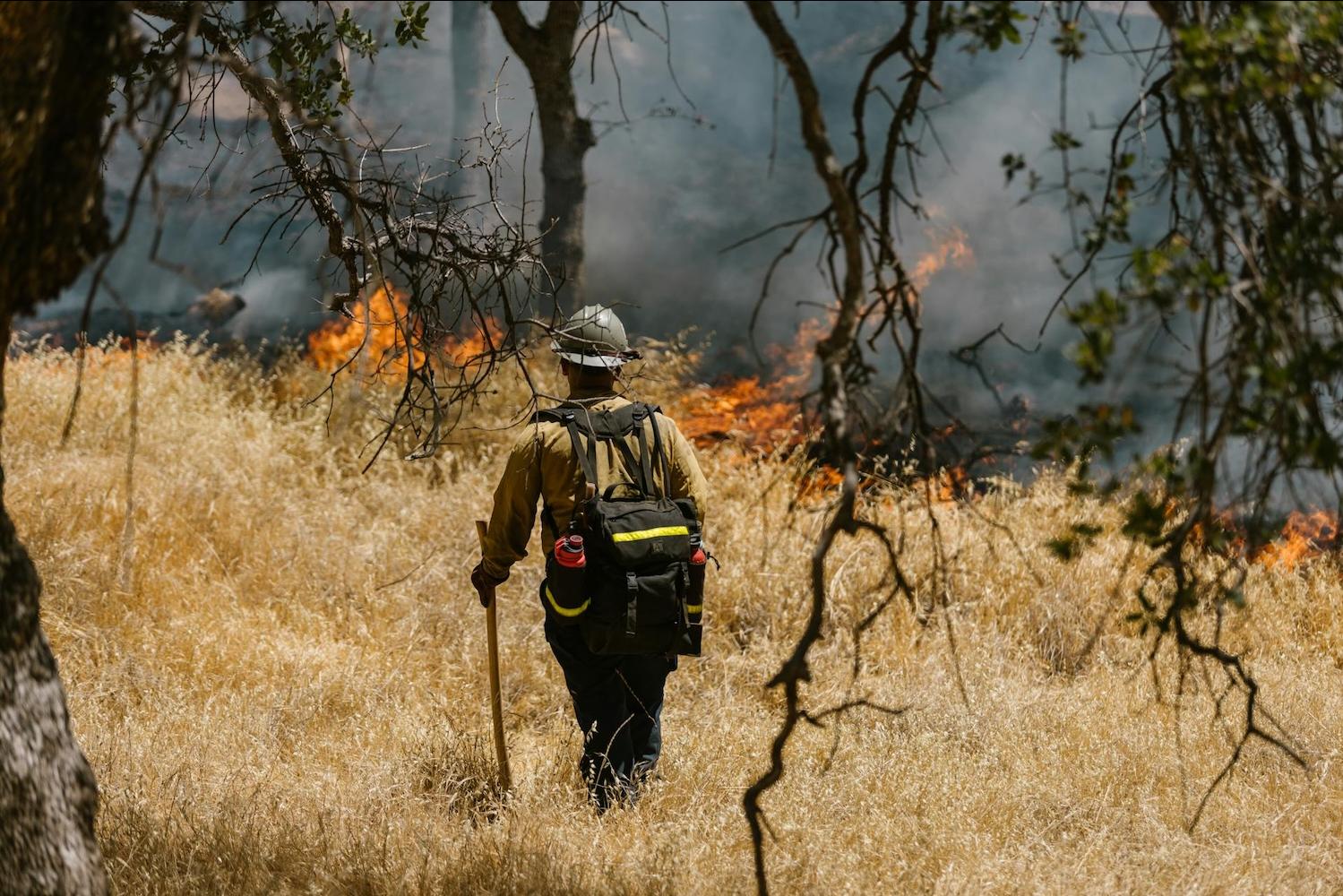
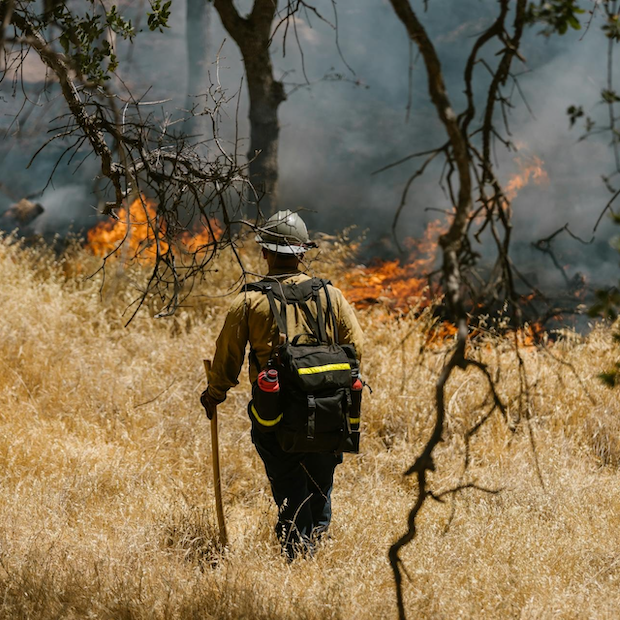
(Image credit: RDNE Stock project/Pexels)
This story was originally published by Grist. Sign up for Grist's weekly newsletter here.
With decades of experience, Reno Red Cloud knows more than anyone about water on the Pine Ridge Reservation in South Dakota. As climate change makes fire season on the reservation — which covers more than 2 million acres — more dangerous, he sees a growing need for water to fight those fires.
Red Cloud is the director of water resources for the Oglala Sioux Tribe and he recently received nearly $400,000 in federal funding to revive old wells that have been dormant for decades. He thinks the wells can produce over a million gallons of water a day. But there’s one catch: They have elevated levels of arsenic.
“We have to look at using these wells,” he said. “They are just sitting there. Instead of plugging them, like a Band-Aid, let’s utilize them for the future of drought mitigation.”
The Oglala Sioux’s water needs have doubled in recent years, with longer and hotter summers and, of course, drought. With more wildfires on the horizon, the water Red Cloud envisions could not only add to the quality of life for those on the reservation, but he sees this as a climate solution for reservations across the nation.
“We think other reservations could do the same,” he said.
Arsenic can’t be seen, smelled, or tasted. It is a natural element found in the upper parts of the Earth’s crust, and while a big dose of it is fatal, the more common issue is consumption of low levels of arsenic over long periods of time.
Jaymie Meliker, a professor at Stony Brook University in New York and an authority on arsenic in drinking water, said the water Red Cloud wants to use should be safe to use to fight fires.
“Nothing is really toxic,” he said. “One of the first things they teach you in toxicology is [that] it’s the dose that makes the poison.”
He said the concentration of arsenic in the soil is measured in parts per million while in the water it is measured in parts per billion. It’s “still a thousandfold as small as the levels that are already in the soil, back into the soil. I don’t see a big risk from that at all.”
The wells were installed in the 1970s when the United States Department of Housing and Urban Development funded and developed them for home projects on reservation land. Back then, the acceptable level of arsenic in a water supply was 50 parts per billion, and then in 2001 the Environmental Health Agency changed it to 10 parts per billion. When that happened, the pumps were plugged up and there were no plans to use them.
Understandingly, some in the area are hesitant when they hear about arsenic. The water many drink on Pine Ridge is pumped in from the Missouri River but the reservation has many private wells with elevated levels of arsenic. Tribes throughout the U.S. are disproportionately affected by elevated levels of arsenic in their private wells, such as those on the Navajo Nation.
A paper outlining a two-year study on arsenic in drinking water among Indigenous communities in the Northern Plains confirmed that those populations have higher levels of arsenic in their water. Prolonged arsenic exposure can lead to cardiovascular disease, diabetes, cancers, and other serious health conditions.
The World Health Organization offers guidelines on the subject, saying, “Low-arsenic water can be used for drinking, cooking and irrigation purposes, whereas high-arsenic water can be used for other purposes such as bathing and washing clothes.”
A funding summary of the tribes project said there was speculation on if the water should be used for agriculture and livestock. So, even though Red Cloud is interested in potentially using this water for livestock and agriculture, there is still more research to be done to look at the viability of these wells for other uses.
Red Cloud helped write the 2020 Oglala Sioux’s Drought Adoption Plan. New water sources were the first solution to mitigate drought in that report. He hopes that other tribes look at their old wells on reservation lands to see if they can help mitigate drought — or if it’s better to just plug them up and let them sit.
“The bottom line is we’re looking to deal with extended drought and the increasing intensity of wildfires,” he said.
This article originally appeared in Grist, a nonprofit, independent media organization dedicated to telling stories of climate solutions and a just future. Learn more at Grist.org.
Zero-Emissions Road Freight in India is a Blueprint for Public-Private Collaboration in Emerging Markets
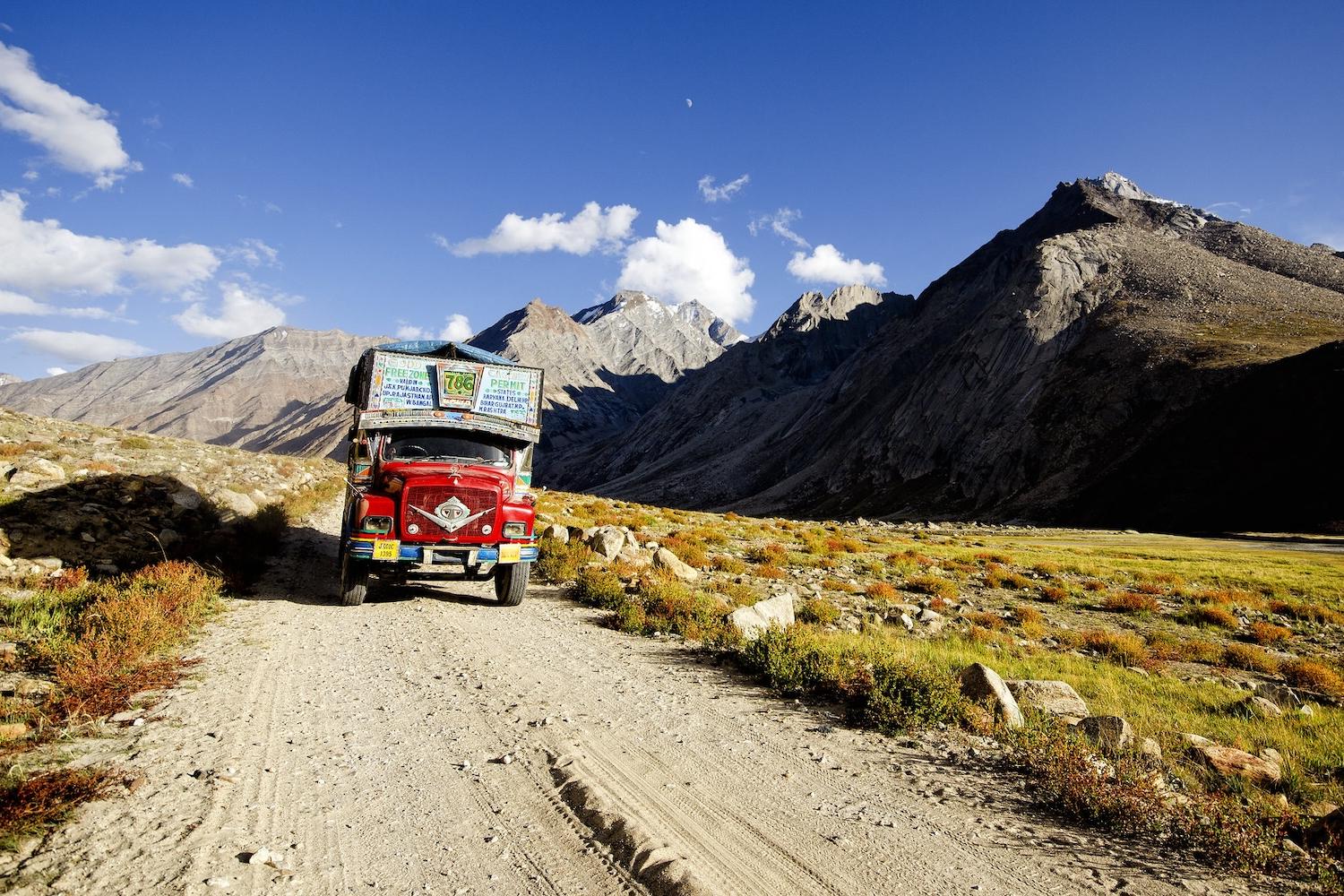
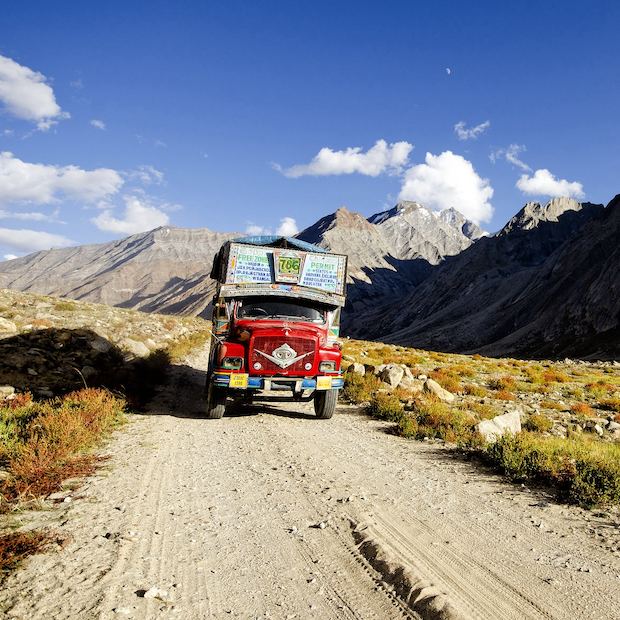
A truck carries annual supplies to the remote village of Padum in the Zanskar region of northern India. Across the country, road freight is the predominant mode of goods movement. (Image: Prabhu B Doss/Flickr)
When it comes to road freight, India is leading the way among emerging markets in accelerating the number of zero-emissions vehicles (ZEV) on the road. And it’s offering a blueprint for others to follow.
Increasing investments along the ZEV value chain in India is the aim of a unique public-private collaboration, the Zero-Emission Vehicles in Emerging Markets Initiative (ZEV-EMI), a model now being replicated in Mexico and other emerging markets.
The pace of decarbonization must accelerate in the face of worsening climate change. Transport is often at the top of sectors that need to do more, and for good reason: Transport accounts for close to a quarter of global energy-related carbon dioxide emissions.
To align with the Paris Agreement, and limit global warming to 1.5 degrees Celsius, 60 percent of global light-duty vehicle sales, 30 to 35 percent of zero-emission truck sales, and 60 percent of zero-emission buses must be electric by 2030, according to the International Energy Agency’s Global EV Outlook 2023. A zero-emission vehicle is any vehicle that emits no harmful pollutants at all from its exhaust pipe. A battery electric vehicle (BEV) is the most common type of ZEV.
Transport is undergoing fundamental transformation to meet the demands of a low-carbon world. But there are significant barriers to decarbonization, including uncertainty around technology deployment roadmaps, supply and demand for zero-emissions vehicles (ZEV) which hampers development, production and adoption along with insufficient financing. These challenges are particularly pronounced in emerging markets.
Electric freight in India
In India, road freight is the predominant mode of goods movement. Despite being less than 3 percent of vehicles, road freight accounts for 64 percent of the nation’s diesel consumption and contributes to 34 percent of road transport emissions.
More than 30 companies have come together under the first phase of Zero-Emission Vehicles in Emerging Markets Initiative. The effort is led by the World Business Council for Sustainable Development (WBCSD) and the U.S. and U.K. governments under the ZEV Transition Council (ZEVTC), along with the Indian government's E-FAST (Electric Freight Accelerator for Sustainable Transport) initiative to advance the electrification of the truck market in India. Companies in the initiative have launched several pilot projects and signaled demand for more than 5,000 electric trucks in India by 2027 and around 7,700 by 2030.
While this represents only 0.20 percent of current truck demand in India, or 4 million trucks on the road in 2022, it provides an important demand signal for further market development. When a number of purchasers come together to pool demand, electric trucks can be produced at a larger scale and lower cost, leap-frogging the technology adoption curve.
The initiative has started to have important ripple effects. A number of shippers are already piloting electric trucks in 2024 and 2025, including Amazon, Aditya Birla- Ultratech, Maersk and JSW, among others. As part of E-FAST, several partners have joined forces toward further e-truck market development, with the ambition to deploy 15,000 trucks by 2030.
As a key enabler, the initiative is also working collectively to accelerate the deployment of charging infrastructure corridors by de-risking infrastructure planning and related investments through data-sharing.
The companies have agreed to work together to deploy electric trucks through a national task force that will stimulate the development of the electric freight market in India. The task force is structured according to a national three-pillar strategy for electrifying trucks, including collecting and aggregating demand across shippers, shaping financing mechanisms for de-risking private investments, and enabling a favorable policy environment.
The incentive for action among the companies is clear, as this contributes to carbon emission reductions in their fleet operations as part of their own decarbonization commitments.
A game-changing approach
The ZEV-EMI initiative is a leading example of the collaboration needed to solve the climate crisis, in that it brings together all the essential actors to deliver real change. In Mexico, where the model is already being replicated, demand is already being collected across fleet operators. This includes trucks, cars and EV infrastructure, demonstrating the usefulness of the India model across different technologies and sectors.
As a multi-stakeholder, co-investment approach, the initiative is a win-win proposition. Companies with a shared strategic benefit can leverage their own investments together with funding from governments and other partners to achieve the scale that no single company or even single country could accomplish on its own.
A key part of what makes the collaboration so successful is that the companies engaged represent the entire value chain, from those who produce goods to those who ship goods and materials. Another critical success factor is the commitment of India’s government to decarbonize its road freight.
With the help of its partners, India is able to accelerate the pace at which it makes that happen. This is the kind of innovative space for collaboration that WBCSD can uniquely cultivate, representing multiple sectors and value chains that can bring a broad perspective to bear on solutions to complex challenges.
Once it all comes together, there is the opportunity to move quickly as demonstrated in India.
A blueprint for emerging markets
Other emerging markets can replicate this approach. Already the ZEV-EMI coalition is coordinating efforts to support Mexico’s zero-emission vehicle transition. The ongoing efforts focus on channeling investments along U.S.-Mexico infrastructure corridors and in urban fleet uptake by replicating the validated India e-truck market creation model.
This blueprint centers on five key elements of best practice: high-level, public-private dialogues to set shared priorities; bringing together purchasers to pool demand for market uptake; optimizing infrastructure investments through digital collaboration; coordinating with the finance community to create bankable projects; and demand-driven capacity-building.
Initiatives such as those led by ZEV-EMI in India help bridge the gap for emerging and developing markets to accelerate electrification of the transport sector, invest in the necessary infrastructure and ensure a resilient global e-mobility supply chain. This level of innovation and action will be critical in the years ahead if we are to shape a sustainable future in transportation.
From Four Wheels to Two: Ditching Your Car for a Cargo Bike
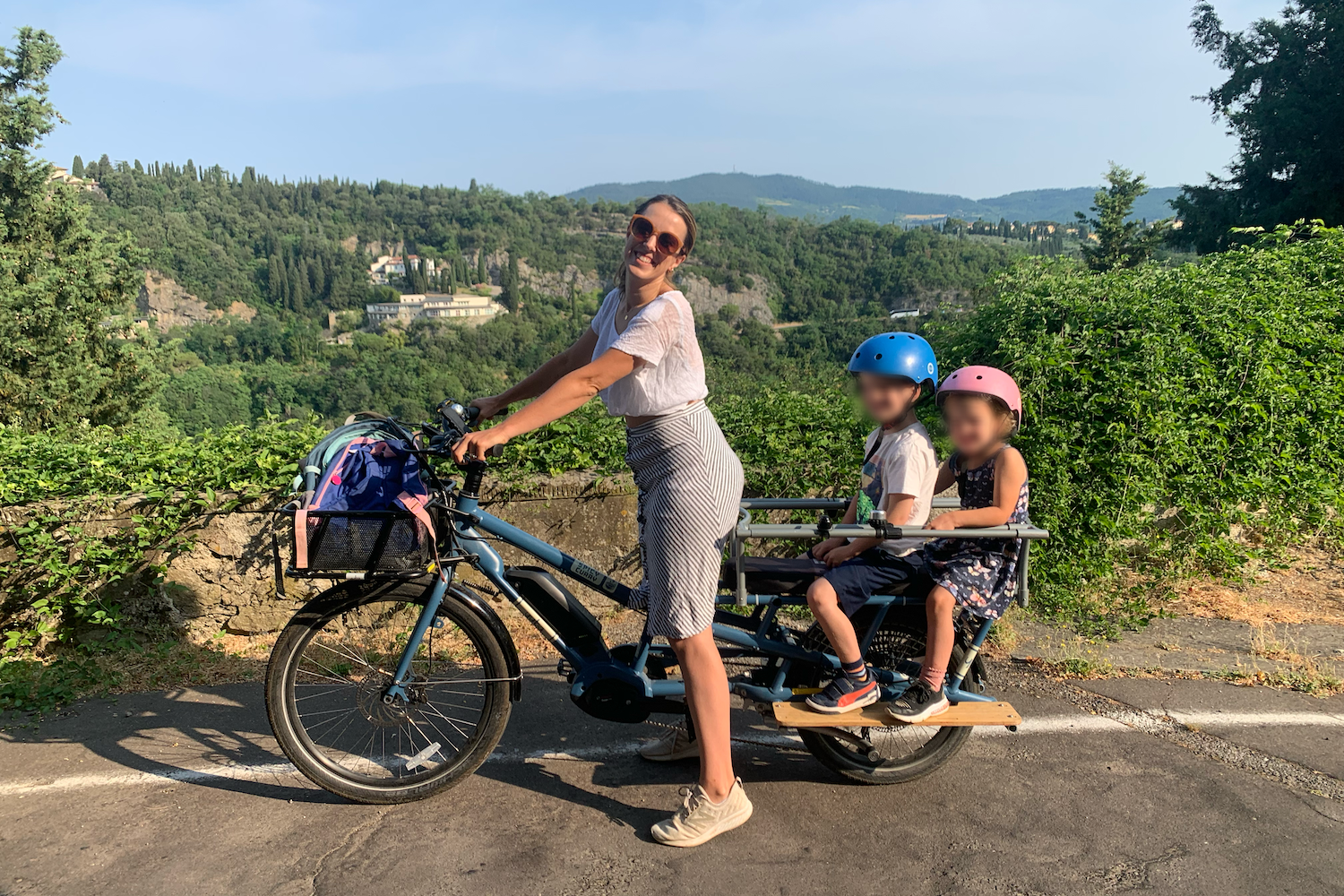
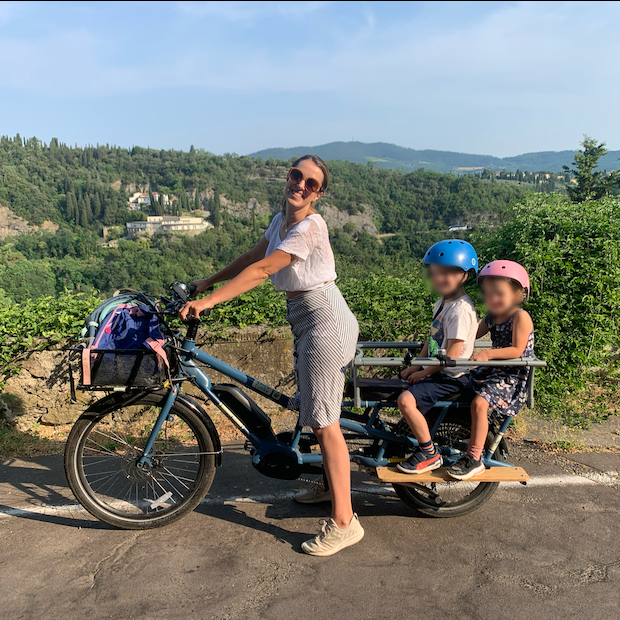
The author cruising around Florence, Italy, on a cargo bike with her two children. (Faces are blurred for privacy; image courtesy of the author)
In 2021, I moved to Florence, Italy, with my husband, two young children, and our dog. Before arriving in Italy, I had never been to Europe aside from a daylong layover in Munich, and I had some misguided assumptions about the region’s public transit system. Before the big move, I proudly told my friends back home that we would not need a car in Florence, because the European way of life would provide us with every train, metro, or bus we could ever need.
As I soon discovered, Europe is not a monolith, and the transit system of Munich was not the transit system of Florence. To complicate matters further, our house was on a hill just outside of the city limits, and the closest bus stop was a 15-minute walk up an impossibly steep incline.
We tried to remain car-free for as long as possible by investing in an electric cargo bike with seats for the children. It was a tremendous help, but it still did not cover all of the logistical needs of a family living in a rural area. We eventually decided to lease a car.
Before then, I often complained about cars being the scourge of Florence. Quaint, arterial roads are treated like freeways, as cars hurtle through the narrow passages at stomach-churning speeds. There are so many cars in the city that Florence’s famed architecture is often hidden behind cars parked two rows deep, on the sidewalks and in the crosswalks. It did not feel good to be a part of the problem.
Several months ago, we decided to move into the city. The Tuscan countryside overlooking Florence is breathtaking, but being in the city afforded us the opportunity to better live out our sustainability values. We once again ditched the car.
Becoming a car-free family (again) meant a shift in lifestyle, but our electric cargo bike made it possible. The bike has enough space to carry two kids and all of the things they bring to and from school and their after-school activities. And it has enough battery power to climb the hills that surround the city. We also bought a rain cover for the kids’ seats and extra lights and bells for safety, along with rainsuits, ponchos, and shoe covers to ensure that we could ride in almost any condition.
The benefits of becoming a car-free household are clear. I reap all of the rewards of regular exercise, but instead of setting time and money aside to go to the gym, it is just built into my day through biking. Additionally, while the initial investment in an electric cargo bike was expensive, we were able to break even in six months by removing costs associated with car payments, insurance and fuel.
Going car-free would not have been possible without a few key factors. First, Florence has a robust system of rental bikes. Our electric cargo bike was expensive, but having access to rental bikes means that we did not need to buy a second one. When we need to go somewhere together as a family, one parent rides our cargo bike with the children while the other rides one of the rental bikes readily available in our neighborhood. And while the public transportation system in Florence is not perfect, it is robust enough to be a good option for travel to areas that are difficult to reach by bike. Finally, for trips to areas that are not serviced by bus or trains, we have the option to rent a car or ride with friends.
Becoming a car-free family has also required extra logistical planning and attention. While Florence has many wonderful, dedicated bike trails, they are not universal, and traffic conditions in Florence are a nightmare. Speed limits in many locations are completely unenforced, and many residential streets are treated like race tracks. As in any other major city, cyclists must always remain vigilant and choose their routes with extra attention, especially when riding with children. Additionally, cargo bikes do not always have the capacity for large shopping trips to procure bulky items.
While there are challenges and limitations, going car-free was the right choice for my family. The children are still young, and riding on the bike together allows us to develop strong connections with our community and environment. We have the freedom to pause and chat with friends we see on the street or stop to admire a beautiful garden. Best of all, my children are old enough to understand that the choices we make can help our planet and community, and they’re getting to live out those choices every day.
This article is part of Travel Month in our 2024 Sustainable Living Challenge, where we unpack accessible ways to see new places and get around your hometown with a lighter impact on the planet. Learn more and take the challenge here.
'Solar For All' Grants Could Boost Community Solar by 25 Percent


Shares of the energy generated by this solar garden at Grand Valley State University in West Michigan are available for local residents to purchase via a community solar program. (Image credit: Consumers Energy/Flickr)
Following $20 billion in grant disbursals last week, the U.S. Environmental Protection Agency (EPA) is expected to announce the winners of the $7 billion Solar For All competition any day.
Solar for All is a competitive grant program that aims to deliver the savings and benefits of small-scale solar and energy storage systems to low-income households and households in disadvantaged communities. Administered by the EPA, the program is part of the $27 billion Greenhouse Gas Reduction Fund created under the Inflation Reduction Act of 2022.
The majority of the organizations up for funding are focused on programs to expand community solar, with 33 of the 35 Solar For All applicants including community solar in their applications, according to an analysis from the Clean Energy States Alliance (CESA). As the name implies, community solar programs allow residents to purchase energy from a shared solar installation, even if they can't put panels on their own roofs.
Conservative estimates indicate community solar capacity in the U.S. would jump by more than 25 percent if these 33 applications are awarded, with most of that growth occurring in low- to moderate-income communities.
Community solar can boost local economies while providing clean energy
Along with clean energy, community solar can bring new economic development from jobs created to build solar energy facilities and from the ongoing maintenance needed to keep those facilities running, said Bruce Stewart, CEO of Perch Energy, a Massachusetts-based community solar servicer. “It also gives local community members an opportunity to subscribe,” he said.
Customers participating in these projects pay to access a portion of the electricity generated by the shared community solar array, usually in the form of a monthly subscription fee. The utility company compensates the community solar provider for the electricity supplied, and each subscriber earns a credit equivalent to their share of the generated energy's monetary value. These credits are commonly deducted from subscribers' monthly electric bills, ultimately lowering their overall electricity expenses.
Community solar subscriptions can provide savings to consumers ranging from 5 percent to 20 percent depending on local regulations, Stewart said.
Low-income Americans spend the most on electricity: Equalizing access to solar can help
Even as the cost of solar energy has declined, half of Americans face affordability, installation or other accessibility issues that keep them from installing rooftop solar panels. Most solar power users are wealthier than the average U.S. consumer. In 2022, the median income for a household with solar power was about $117,000 per year, compared to a U.S. median income of about $69,000 per year for all households and $86,000 per year for all owner-occupied households.
Lower-to-moderate income households also spend 8.6 percent of their income on energy costs, roughly three times more than households with higher income.
Community solar can help, but first the sector has to convince residents it's worth their time. Most outside of the sustainability community are not familiar with community solar, so advocates are challenged to raise awareness among potential customers about the availability and benefits of these programs.
It's easier in some states than others. In some jurisdictions, for example, solar discount credits appear on a separate bill, confusing and discomfiting customers. “That’s a big point of unease for folks," Stewart said, meaning state legislators — along with the EPA — have a major influence on how community solar scales up.
States including Massachusetts, New York, Maryland, New Jersey, Maine, Minnesota, Illinois, and Virginia recently enacted or are expanding regulations that support community solar programs, Stewart said.
“We’re seeing states like New Jersey that moved from pilot programs where you had a separate bill to enabling all of the credits to [show up] right on the customer’s utility bill,” he explained. “Making it simple and easy for folks is great."
More than 7.3 gigawatts worth of community solar is already up and running in the U.S., enough to power over 5.2 million homes. Since the Solar for All competition was announced, a growing number of U.S. states have moved to further promote these programs as a way to bring more renewable energy into their local electric grids.
“We’re seeing that happen in states with existing community solar, but we’re also seeing lots of states that have been on the sidelines that are watching these programs, seeing the positive economic development that’s happening, seeing how it actually is helping shift to a broader set of renewables that will always have a mix in the electricity grid,” Stewart said.
The EPA will announce the grant awards in the Solar for All competition later this month.
'Awesome, Historic, Momentous.' U.S. EPA Distributes $20 Billion for Climate Justice: Now the Work Begins


EPA Administrator Michael Regan announces the grant awards from the Greenhouse Gas Reduction Fund in Charlotte, North Carolina, on April 4. (Image: U.S. EPA via Flickr)
Low-income communities and communities of color across the United States faced health impacts from outsized air pollution for generations, and they're now among the first to feel the worst effects of climate change. On Thursday, the U.S. Environmental Protection Agency (EPA) announced $20 billion in grants aimed at righting these historic wrongs and ensuring communities actually benefit from growing sectors like clean energy.
Awardees include coalitions of nonprofit organizations, state and local agencies, and lenders like green banks and community development financial institutions (CDFIs). The projects they proposed will collectively avoid up to 40 million metric tons of greenhouse gas emissions per year, more than the annual emissions of Switzerland, Ireland and Denmark, while reducing air pollution and energy costs in their communities, according to the EPA.
Climate and economic justice advocates praised the EPA for its historic progress in mobilizing public and private capital within historically disadvantaged parts of the country. So, what's next for the winners, and how can business leaders, philanthropists and everyday people get involved?

Winners hit the ground running with EPA funds set to arrive in the coming months
Thursday's was an early but happy morning for Trenton Allen, CEO and founder of the financial advisory firm Sustainable Capital Advisors, who worked with organizations to prepare their applications for EPA funding. "I had a big smile when I saw the official news," Allen told TriplePundit by phone on Thursday. "I got up at 5 o'clock when the administration said they were going to release it to make sure I could see it live and in color."
A number of the organizations Allen's firm advised were ultimately selected — including the Ohio Air Quality Development Authority and the National Bankers Association, which advocates for minority deposit institutions (MDIs) that are majority-owned by people of color.
"Put into perspective that $20 billion have been allocated for the purpose of not just climate, but climate in our most underserved communities. That's huge," Allen said. "Whether organizations received money, didn't receive as much as they wanted to, or didn't get any at all, I think we all can collectively say that this amount of money — particularly for the benefit of communities across the country — is incredibly important, groundbreaking and transformational."
The awards were distributed under two separate grant competitions, the $14 billion National Clean Investment Fund and the $6 billion Clean Communities Investment Accelerator. The former looks to establish "national clean financing institutions" that deploy capital for clean technologies and energy efficiency at scale, while the latter will support community lenders working on the ground in historically disadvantaged communities.
"When you think about the United States' persistent wealth gap that harms many communities, and the societal and economic fabric of our nation as a whole, this investment will begin to enable many of those communities previously left out to help tackle climate change in their own backyards," said Lenwood V. Long Sr., CEO of the African American Alliance of CDFI CEOs, which represents 76 Black-led financial institutions.
The Alliance is a founding member of the Justice Climate Fund, a coalition of nearly 20 financial institutions led mostly by people of color and another of Allen's clients, which received nearly $1 billion through the Clean Communities Investment Accelerator.
In the coming weeks, groups like the Justice Climate Fund will work with the EPA to get contracts in place and ensure projects are aligned with the overarching objective of reducing emissions and air pollution. "We anticipate by June that money will be flowing to the Justice Climate Fund," Long said.
The CDFIs, MDIs, credit unions, and green banks in the Fund will deploy the grants to support projects like energy-efficiency upgrades, programs to expand heat pumps and other clean technologies that cut energy use and costs for residents, and electric vehicle charging stations for businesses and public places, Long said.
The coalition is already working to prepare member financial institutions for what's ahead. Today in Washington, D.C., the Alliance hosted an in-person and virtual workshop for members with the National Bankers Association, the National Association for Latino Community Asset Builders and Oweesta, which serves CDFIs led by Native American communities.
"We are not waiting until money starts flowing," Long said. "We have begun the process, as we have done before, of preparing our members for this awesome, historic, momentous opportunity."

"Now it's on us."
Following the announcement, awarded organizations will also begin the hard work of reassessing their planned projects in light of the funding they received. "I don't know what everyone asked for, but I'm pretty confident that no one got all the money they requested in their initial application," Allen said. "What that means is now you have to make some determinations and some adjustments with regard to your strategy."
Such work may necessitate tradeoffs, but it also creates opportunity for the winning organizations — and other stakeholders across the financial community — to work together to ensure funds are deployed to create the greatest impact possible.
"Because everyone got less money than what they originally asked for, we need to make sure we aren't duplicating services or duplicating efforts so that we can be as efficient as we can," Allen said. Early signs indicate the awardees have a healthy appetite for collaboration with each other to supplement and complement their work. "I've gotten signals that it’s something the winners want to do," Long added.
Beyond the awarded organizations, business leaders, financial professionals and the general public also have roles to play. "The administration created a program and has some clear goals and targets about what it's looking to achieve," Allen said. "I believe in their allocation of dollars, they've given themselves a chance to make that happen. Now it's on us to make sure it does happen."
That even includes conservative critics who lambasted the EPA grants as a “slush fund” doling out unrestricted billions to organizations without proven track records. "It's sad that any time there's something targeted for low-income and disadvantaged communities, people make it political, and it shows the racist and classist fight in America around economic justice and equity," Long said. "To all the pundits who say this is a pork barrel bill, this is money to organizations that don't have internal controls, join us in helping to make this work rather than sit on the sidelines and criticize and hope for failure. You ought to pray for success, because this money is going to all communities."
Despite rhetoric to the contrary, the EPA grant program has clear requirements: All projects must demonstrably reduce greenhouse gas emissions, and all awardees must report their progress publicly on an ongoing basis. "People need to understand that there's not a dime flowing to anyone who does not meet this litmus test of reducing carbon emissions," Long said.
The Joe Biden administration and the EPA also aim to multiply the grants provided under the $27 billion Greenhouse Gas Reduction Fund by attracting private capital — from businesses, financial institutions and philanthropists, as well as everyday people looking for climate-friendly investments and financial services.
"$20 billion is a lot of money, but it's not enough money," Allen said. "One of the things that these dollars have an opportunity to do is to help to animate, excite and allow communities to see how they can best participate. I am really hopeful about how these dollars can lead to a transformation that this country has not seen as it comes to climate, but also economic opportunity and economic development."
Long agreed, saying that while much work is left to do, the way funds were allocated represents a monumental step forward. "This is the only program I've seen where you take $15 billion of the $27 billion and those funds are targeted for low-income and disadvantaged communities," he said. "I'm looking at institutions around America that are preparing for this moment. Here in my state, North Carolina, the community college system has a program around EV charging stations for students and entrepreneurs. They know what's coming."
The New U.S. 'Green Bank' is Part of a Great American Tradition


President Joe Biden and union members building Intel's Ocotillo Campus walk onstage before announcing $20 billion in investments to ramp up production of semiconductor chips on March 20, 2024, in Chandler, Arizona. Another $20 billion in funding geared toward clean technology investments in underserved communities was announced last week. (Official White House Photo by Adam Schultz via Flickr)
The 2022 Inflation Reduction Act provides billions in public subsidies to corporate citizens for new clean technology investments. It also sets up so-called “green bank” financing programs focused on disadvantaged communities. Republicans in Congress have taken steps to dismantle it, but they may want to crack open a history book before they go any further. The green bank formula is rooted in public initiatives that transformed parts of the U.S. Southeast from deep poverty in the early 20th century to the economic powerhouse of today, much to the benefit of businesses and individuals alike.
The 2022 Inflation Reduction Act and taxpayer support for businesses
Democratic members of Congress initially introduced the 2022 Inflation Reduction Act under the catchphrase “Build Back Better,” promoting it as President Joe Biden’s signature climate action legislation. No Republican members of Congress voted to support it, even after Democratic Sen. Joe Manchin advocated to weaken its provisions.
The opposition included the Republican Congressional delegation from Tennessee. “Senate Democrats have forced through a socialist agenda that will make life more difficult and expensive for Tennesseans,” U.S. Sen. Marsha Blackburn of Tennessee said when explaining her vote against the bill.
U.S. Rep. John Rose of Tennessee's sixth district chose to focus more narrowly on the cost of the legislation. “Amidst a spending-induced recession and record-breaking price increases for everything, Democrats doubled down on their disastrous policies by ramming through a bill that costs taxpayers hundreds of billions of dollars on a party-line vote that will only make matters worse,” he said.
Rose’s opposition to taxpayer-funded programs is particularly ironic considering that he describes himself as an “eighth-generation farmer.” Farms in his Congressional district have received millions in public subsidies over the past 30 years. The Environmental Working Group compiled data from the U.S. Department of Agriculture which indicates “farms in 6th District of Tennessee (Rep. John Rose) totaled $135,717,000 from 1995 through 2021.”
Tennessee reaps the rewards of the Biden-Harris “Invest in America” initiative
Regardless of the partisan opposition, news reports indicate Republican-led states are receiving an outsized share of benefits under the Inflation Reduction Act, including states located in the Southeast.
“Whereas Southern states led by Republicans did not vote for climate spending, they are embracing clean energy dollars a lot more than their blue counterparts," Oil Price reporter Alex Kimani noted last year. States including Tennessee, Georgia, Kentucky, Indiana, Michigan, Ohio and the Carolinas even earned the name the “battery belt" for their recent electric vehicle and EV battery investments, Kimani reported.
To be clear, the Inflation Reduction Act is just a third of the Biden-Harris administration’s Invest in America Agenda. The other two pillars are the Bipartisan Infrastructure Law and the Creating Helpful Incentives to Produce Semiconductors (CHIPS) Act, both of which received a modicum of bipartisan support. In a recap issued last year, the U.S. Treasury Department reported that “real manufacturing construction spending has doubled” under the Invest in America agenda.
The U.S. Department of Energy also drilled down into the benefits of Invest in America for the manufacturing sector in Tennessee in particular, noting that the state has attracted $14 billion in investment in the EV battery supply chain alone. Among the supply chain manufacturing highlights, the Energy Department awarded $150 million to Novonix Anode and $141 million to Piedmont Lithium to set up shop in Tennessee.
The U.S. green bank started with the 1933 Tennessee Valley Authority Act
Tennessee’s agriculture industry is also gaining benefits from Invest in America. “Thanks to Inflation Reduction Act funding, more farmers and more acres are enrolled in voluntary conservation practices than at any single point in history,” the U.S. Department of Agriculture's Fiscal Year 2023 update reads. Even with this "unprecedented funding," the agency says it's "seeing more demand than we have funds to support."
That means “more farmers, rural businesses, utilities and electric cooperatives will also be able to reduce their energy costs, leaving more dollars in the hands of rural communities,” the USDA added in its update.
That reference to electric cooperatives is important. Rural communities in Tennessee and much of the surrounding region were mired in poverty until the Tennessee Valley Authority Act of 1933 established a series of publicly-funded dams to reduce flooding and produce electricity “at reasonable rates” for farms and villages in the region. That was followed by the 1936 Rural Electrification Act, which provided federal funding to set up distribution networks elsewhere in the country.
When private utilities balked at investing in sparsely populated areas, local farmers formed cooperatives to apply for the funds. The Franklin D. Roosevelt administration encouraged them under the 1937 Electric Cooperative Corporation Act. To this day, 900 member-owned, not-for-profit rural electric cooperatives and related entities cover 56 percent of the U.S. landmass and serve around 42 million people.
Electric cooperatives also represent 92 percent of the counties classified as “persistent poverty” counties. These are exactly the counties that stand to benefit under the new green bank initiative led by a new round of $20 billion in competitively awarded federal grants to eight organizations through the Inflation Reduction Act, announced by the U.S. Environmental Protection Agency on April 4.
Together, the funds comprise a “national clean financing network for clean energy and climate solutions across sectors,” the EPA's announcement reads. “By financing tens of thousands of projects, this national clean financing network will mobilize private capital to reduce climate and air pollution while also reducing energy costs, improving public health, and creating good-paying clean energy jobs in communities across the country, especially in low-income and disadvantaged communities."
The green bank in action
The EPA split the $20 billion between two programs. Of the total, $14 billion is earmarked for three organizations under the National Clean Investment Fund. These three organizations — Climate United Fund, Coalition for Green Capital and Power Forward Communities — have been created in partnership with United Way, Habitat for Humanity, and other experienced community groups. They are tasked with establishing new financial institutions that provide “accessible, affordable financing for clean technology projects nationwide.”
The remaining $6 billion goes to five organizations through a program called the Clean Communities Investment Accelerator. This group will create assistance hubs for community lenders, with the aim to get some projects off to a quick start while developing sustainable, long-term financing platforms for future projects.
Four of the awardees — the Opportunity Finance Network, Inclusiv, Appalachian Community Capital and the Native CDFI Network — have years or even decades of experience in community finance and credit unions. The EPA describes the fifth organization, called Justice Climate Fund, as a “purpose-built nonprofit” supported by an existing member network and more than 1,200 community lenders with decades-long track records, as well as the experienced nonprofit asset manager ImpactAssets.
The bar is set high: Will the private sector responds?
Last week, Associated Press reported that Republicans lawmakers in the House of Representatives have called the new funding program a “slush fund” and took steps to repeal the green bank along with “other parts of President Joe Biden’s climate agenda.”
They may have to deal with pushback from their own constituents. Rural electric cooperatives have already leveraged their community-centered business model to take a leadership role in the nation’s renewable energy transition through funding from both the USDA and the Energy Department. More likely than not, they will also play a decisive role in the success of the new green bank initiative.
As for private-sector investors, money talks, and it is talking about rural communities. A new analysis by the organization E2 indicates that the Inflation Reduction Act is already expected to stimulate $20 billion in private-sector investments related to large-scale clean technology investments in rural counties.